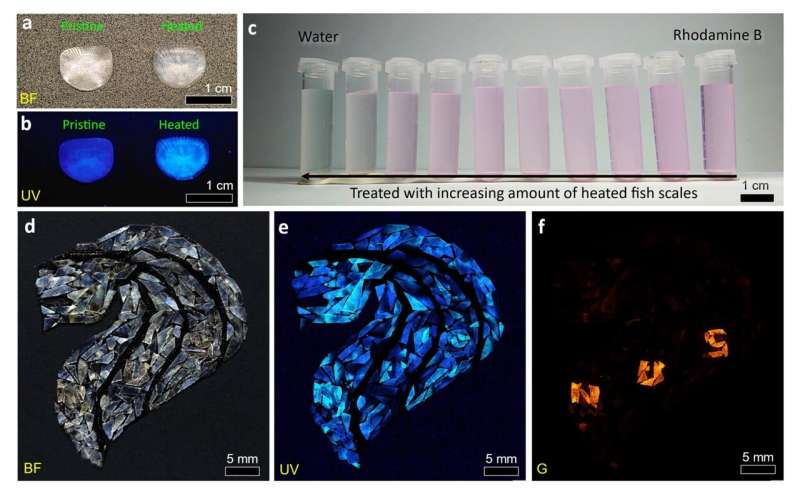This article has been reviewed according to Science X's editorial process and policies. Editors have highlighted the following attributes while ensuring the content's credibility:
fact-checked
peer-reviewed publication
trusted source
proofread
Fish scale waste: A sustainable solution for security and pollution control

National University of Singapore (NUS) physicists have developed a method of converting fish scale waste into a versatile material with dual functionalities—encryption of sensitive information and acting as a bio-adsorbent to effectively remove Rhodamine B pollutant.
Seafood is a delicacy that many enjoy, and globally, an estimated 7.2 to 12 million tons of fish waste are projected to be discarded yearly. This makes fish scale waste an abundant natural resource ripe for exploration for alternative upcycling initiatives as we strive towards sustainable living.
With increasing population and limited resources, a potential route for improving sustainability lies in the increased reuse of waste materials. By relooking at waste materials, researchers can uncover interesting properties and multifunctionalities that were previously overlooked.
Professor Sow Chorng Haur from the Department of Physics, NUS and his research team discovered that by subjecting fish scale waste to optimal heating conditions, the material undergoes a significant change, emitting a vibrant cyan color distinct from its original dim royal blue fluorescence under ultraviolet light. The change can occur on a large scale (using a hotplate) and on a micron scale (using a focused laser beam).
The researchers found that these treated fish scales demonstrate remarkable efficacy as adsorbents for Rhodamine B, a common dye associated with potential health risks and threats to marine ecosystems. Moreover, the ability to tune the fluorescence allows text and images to be engraved onto the fish scale surface without apparent physical changes, presenting the material as a natural medium for multidimensional security, capable of transmitting micro- and macroscopic text and imagery.
The research team, including Dr. Sharon Xiaodai Lim from NUS, Dr. Zhang Zheng from the Agency of Science, Technology and Research, and Mr. Malcolm SOW Miao Geng from the NUS High School of Math and Science, published their findings in the journal Nature Communications.
Fish scales primarily consist of interlacing collagen, a protein known for its role in maintaining a youthful appearance and hydroxyapatite (HAp), a mineral found in bones and teeth. Due to their good biocompatibility, different methods have been developed to extract these components and functionalize them into fluorescence labels for in vivo studies.
However, these processes often require significant amounts of time, energy, and chemical resources. Therefore, there is a strong desire to achieve fluorescence enhancement of the fish scales through a more direct and efficient method, so as to reap the economic benefits of this low-cost waste material.
When heated, the fish scale waste undergoes both chemical and physical changes. The long chains of collagen are broken down into smaller segments that emit blue light under ultraviolet excitation. Simultaneously, alterations occur in the arrangement of atoms, creating surface and internal pores that transform the fluorescence properties and enhance pollutant adsorption.
The treated fish scales when used as an adsorbent for the dye, effectively removed Rhodamine B pollutants (91% removal) within a short 10 minute contact time. The fish scales contaminated with Rhodamine B molecules are recoverable through a simple sonication process for sustainability purposes.
Looking ahead, the research team is keen to develop these treated fish scales into economical and readily accessible Rhodamine B test kits for use in outfield detection. This approach will help minimize the risk of Rhodamine B consumption/ exposure for civilians relying on natural water bodies and outfield scientists while transporting contaminated water sources.
Prof Sow said, "As the global population grows and resources become more limited, a potential route to enhance sustainability involves a greater emphasis on reusing waste materials. By re-evaluating waste streams, interesting properties and multifunctionalities can be discovered in materials that may have been overlooked previously."
More information: Malcolm Miao Geng Sow et al, Upcycling fish scales through heating for steganography and Rhodamine B adsorption application, Nature Communications (2023). DOI: 10.1038/s41467-023-42080-1
Journal information: Nature Communications
Provided by National University of Singapore





















